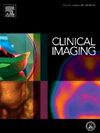Heart lung axis in acute pulmonary embolism: Role of CT in risk stratification
IF 1.8
4区 医学
Q3 RADIOLOGY, NUCLEAR MEDICINE & MEDICAL IMAGING
引用次数: 0
Abstract
Pulmonary embolism (PE) remains a significant cause of mortality requiring prompt diagnosis and risk stratification. This review focuses on the role of computed tomography (CT) in the risk stratification of acute PE, highlighting its impact on patient management. We will explore basic pathophysiology of pulmonary embolism (PE) and review current guidelines, which will help radiologists interpret images within a broader clinical context. This review covers key CT findings which can be used for risk stratification including indicators of right ventricular (RV) dysfunction, clot burden, clot location and left atrial volume. We will discuss the measurement of RV/LV diameter ratio as a key indicator of RV dysfunction and its limitations and challenges within various patient populations. While these parameters should be included in a radiologist's report, their predictive value for mortality depends on the patient's existing cardiopulmonary reserve and should not be interpreted in isolation.
急性肺栓塞的心肺轴:CT 在风险分层中的作用
肺栓塞(PE)仍然是导致死亡的重要原因,需要及时诊断和进行风险分层。本综述重点介绍计算机断层扫描(CT)在急性肺栓塞风险分层中的作用,并强调其对患者管理的影响。我们将探讨肺栓塞(PE)的基本病理生理学并回顾当前的指南,这将有助于放射医师在更广泛的临床背景下解读图像。本综述涵盖可用于风险分层的关键 CT 结果,包括右心室 (RV) 功能障碍指标、血块负荷、血块位置和左心房容积。我们将讨论作为右心室功能障碍关键指标的右心室/左心室直径比的测量及其在不同患者人群中的局限性和挑战。虽然这些参数应包括在放射科医生的报告中,但它们对死亡率的预测价值取决于患者现有的心肺储备,不应孤立地进行解释。
本文章由计算机程序翻译,如有差异,请以英文原文为准。
求助全文
约1分钟内获得全文
求助全文
来源期刊

Clinical Imaging
医学-核医学
CiteScore
4.60
自引率
0.00%
发文量
265
审稿时长
35 days
期刊介绍:
The mission of Clinical Imaging is to publish, in a timely manner, the very best radiology research from the United States and around the world with special attention to the impact of medical imaging on patient care. The journal''s publications cover all imaging modalities, radiology issues related to patients, policy and practice improvements, and clinically-oriented imaging physics and informatics. The journal is a valuable resource for practicing radiologists, radiologists-in-training and other clinicians with an interest in imaging. Papers are carefully peer-reviewed and selected by our experienced subject editors who are leading experts spanning the range of imaging sub-specialties, which include:
-Body Imaging-
Breast Imaging-
Cardiothoracic Imaging-
Imaging Physics and Informatics-
Molecular Imaging and Nuclear Medicine-
Musculoskeletal and Emergency Imaging-
Neuroradiology-
Practice, Policy & Education-
Pediatric Imaging-
Vascular and Interventional Radiology
 求助内容:
求助内容: 应助结果提醒方式:
应助结果提醒方式:


